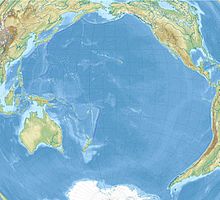Musicians Seamounts
Coordinates: 30 ° 0 ′ N , 163 ° 30 ′ W
The Musicians Seamounts or Composers are a group of deep-sea mountains in the North Pacific north of the Hawaiian Archipelago named after composers such as Beethoven and Bach . It consists of a chain of individual, typically formed seamounts running relatively precisely in a north-west-south-east direction, which forms an angle of about 30 ° with the Hawaii chain. In addition, to the east of the north-west and south-east end of this chain are approximately east-west-oriented, relatively elongated elevations.
In the 1990s, analysis of rock samples taken from the seamounts confirmed their volcanic origin. The age of the basaltic samples was determined to be 96 to 75 million years ( Upper Cretaceous ), with the northwestern seamounts being the oldest and the age gradually decreasing towards the southeast, which leads to the formation of this chain through a hotspot , similar to that for the Hawaii Emperor- Chain is accepted, suggests. However, the sampling of the east-west-oriented ridges at the beginning of the 21st century produced surprising findings. At 53 to 47 million years ago (early Eocene ), these were significantly younger than the samples from the Seamount chain. An in-depth analysis of the composition of these samples also showed that they are more similar to basalts formed on mid-ocean ridges ( MORB ) than basalts from seamounts formed via hotspots ( OIB ). This is interpreted to mean that tectonic tensions increased in this part of the Pacific plate in the early Eocene , which led to the reactivation of old, deep-reaching fracture systems in the oceanic crust . At the reactivated fractures, the top mantle experienced a pressure relief, as a result of which magmas with the MORB signature could melt there, which rose to the sea floor and caused submarine volcanism. The cause of the tectonic tensions is assumed to be an acceleration of the northwest-directed movement of the Pacific plate after the complete subduction of the Izanagi plate under East Asia and the beginning of the subduction of the Pacific plate on the western edges of the Pacific basin around 50 million years ago. This acceleration is also at least partly responsible for the "kink" in the Hawaii-Emperor chain.
Web links
- Composers provide explanation for Hawaii-Knick Press release on the website of the GEOMAR Institute of April 27, 2015 for the publication of the article by O'Connor et al. in Nature Geoscience
Individual evidence
- ↑ Malcolm S. Pringle, Age Progressive Volcanism in the Musicians Seamounts: A Test of the Hot Spot Hypothesis for the Late Cretaceous Pacific. Pp. 187-215 in: Malcolm S. Pringle, William W. Sager, William V. Sliter, Seth Stein (Eds.): The Mesozoic Pacific: Geology, Tectonics, and Volcanism. Geophysical Monograph, Vol. 77. American Geophysical Union, 1993, ISBN 978-0-875-90036-0 .
- ↑ John M. O'Connor, Kaj Hoernle, R. Dietmar Müller, Jason P. Morgan, Nathaniel P. Butterworth, Folkmar Hauff, David T. Sandwell, Wilfried Jokat, Jan R.Wijbrans, Peter Stoffers: Deformation-related volcanism in the Pacific Ocean linked to the Hawaiian-Emperor bend. In: Nature Geoscience. Vol. 8, No. 5, 2015, pp. 393–397, doi : 10.1038 / NGEO2416 (alternative full text access : ResearchGate ).
